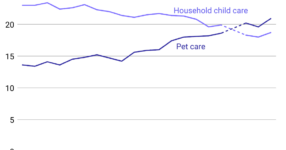
More dogs, fewer babies: What’s guiding the shifts in pet ownership and parenting in American households? | Clayton News Photo Slideshows
The fastest-growing generation of pet parents are those aged 25 to 34, which include millennials and Gen Zers. This age group, though, still has more households caring for kids (30.8%) than households watching over pets (22.9%), though the gap has narrowed in the last two decades. For those aged 45 to 54, the ratio evens out: They are as likely to take care of children as they are to care for pets. At 55, the odds shift the other way: By then, this age group is more likely to care for pets, coinciding with the transition into retirement.
In the U.S., 4 in 5 (82%) millennials are also most likely to view their pets as children, according to May 2024 data from the Statista Research Department. Still, they spend the least on their pets based on BLS data. (The dataset did not compare Gen Z figures due to a reporting error.)
This counterintuitive relationship may reveal some insights about the decline in households with children. Because wage growth has not kept pace with increasing housing costs, based on BLS and Federal Housing Finance Agency data, many adults must now prioritize developing their careers for years before they can afford to establish and care for families. According to a study by the Harvard Joint Center for Housing Studies, the home price-to-income ratio reached an all-time high in many metros in 2022, the latest year measured. Additionally, the percentage of young workers with employers who provide health insurance has plummeted since 1989, further challenging those in need of maternal care or health insurance for their children.
While it is true that birth rates for millennials and Gen Zers taken together have declined, this is still subject to change. As of 2024, about 1 in 5 Americans are choosing to have their first child after age 35, and the average age of first-time mothers is at a record high of 27.5 and climbing, according to 2021 data from the CDC, the latest available. But no matter how family structures and dynamics continue to evolve, pets appear to be along for the ride for the foreseeable future. As animal shelter populations continue to increase, hopefully the households welcoming multiple species will too.
Story editing by Carren Jao. Additional editing by Kelly Glass. Copy editing by Paris Close. Photo selection by Lacy Kerrick.
This story originally appeared on Ollie and was produced and distributed in partnership with Stacker Studio.



